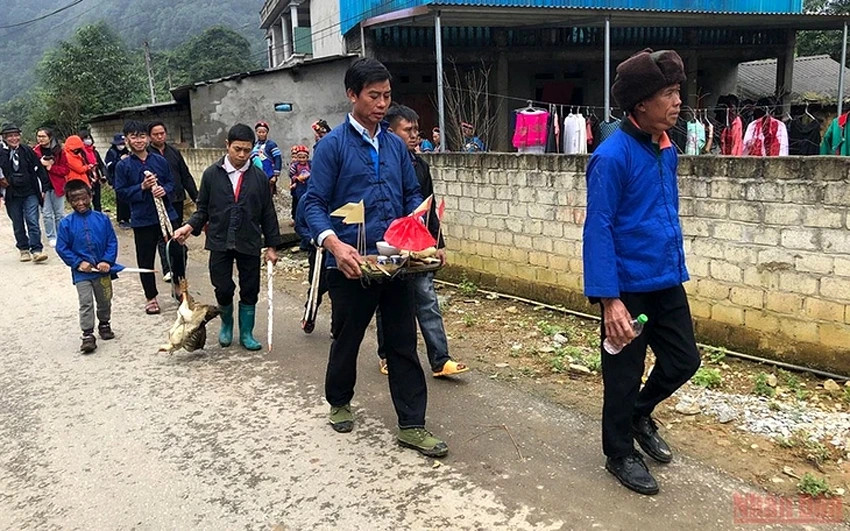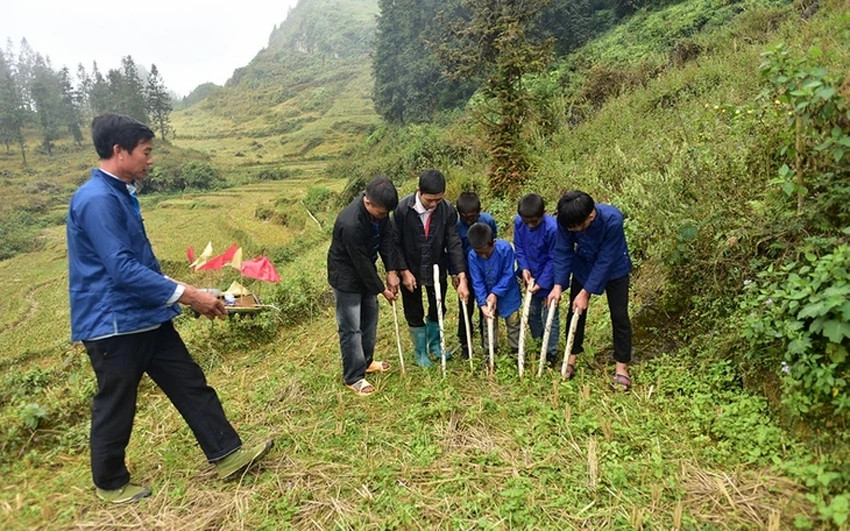

The Phu La ethnic group has about 12,000 people, scattered throughout Lao Cai, Yen Bai, Dien Bien, and Ha Giang province. The Phu La are also known by other names, such as Xa Pho, Pho, or Mu Di Pa.
Throughout the year the Phu La perform many customs and rituals, including welcoming the new rice, celebrating the Lunar New Year ceremony, going to the field, worshipping the forest, and sweeping away the village ghosts.
According to artisan Vang Ngoc Sang of Sa Pa town in Lao Cai province, the two big annual ceremonies are worshipping the forest and sweeping away the village ghosts.
“Sweeping away the ghosts is not about sweeping the ground with a broom. It’s actually a form of worship to chase away evil spirits and bring good things into our village,” Sang says.
The Phu La believe that there are times in a year when ghosts enter the village to disturb the villagers and cause difficulties.
“We hold the ritual to pray for good health, productivity, and economic development. We also pray for good animal husbandry,” explains shaman Vang Ghi Nho of Sa Pa town.
The ghost sweeping ritual is a community event, so the village chief and senior villagers play the important role in organizing it in a solemn way. After choosing an appropriate date, the villagers meet to assign roles for the ceremony. Each family must contribute something, maybe a pig, a chicken, goat meat, fruits, or cakes. The offerings must include a dog, a white-feathered chicken, and a red-feathered chicken, which the Phu La believe have the power to chase away ghosts.
The ghost-sweeping ritual usually takes place in a large, open field. The altar is positioned to direct the ghosts out of the village and into the forest, so they no longer will cause trouble for the village. Before the ritual each family makes wooden knives and guns to ward off the evil spirits, and weaves a bamboo fence to hang on their door to prevent evil spirits from entering the house.

Before the ceremony, each family worships their ancestors at home. At the appointed time, the men bring their offerings to the field and begin the sweeping ceremony. Artisan Vang Ngoc Sang says that, while the forest worship ceremony is a sacred ritual, the ghost sweeping ceremony is both a ritual and a fun, relaxing festival. The ritual asks the Heaven God and the Mountain God to chase the ghosts wandering in the village back to the forest, so they can’t harm people or livestock.
Then the ceremony turns into a festival with everyone, young and old, joining in. Sang says, “I place a tray of offerings, put a chicken and the wooden knives and guns on the tray, and wait for the shaman to come with two reeds more than a meter long, which he uses to sweep.”
The shaman sweeps every house with a reed-mop, while the homeowner throws corn kernels into every corner to urge the ghosts out of the house. The shaman goes from house to house, and the homeowners close their doors behind him. Finally, everyone goes back to the ritual spot to chase the ghosts into the forest. They plant wooden knives and swords at the edge of the forest to deter the ghosts from returning.
For three days following the ritual, the Phu La people refrain from singing or making any loud noise in their house.
“Don’t make any loud noise. Every household must do this. And we must speak only our group’s language. We mustn’t speak any other language,” Sang explains further.
Although science has improved their life in many ways, the Phu La preserve old customs like sweeping away evil spirits because they want to preserve their traditional culture and its beliefs.
VOV